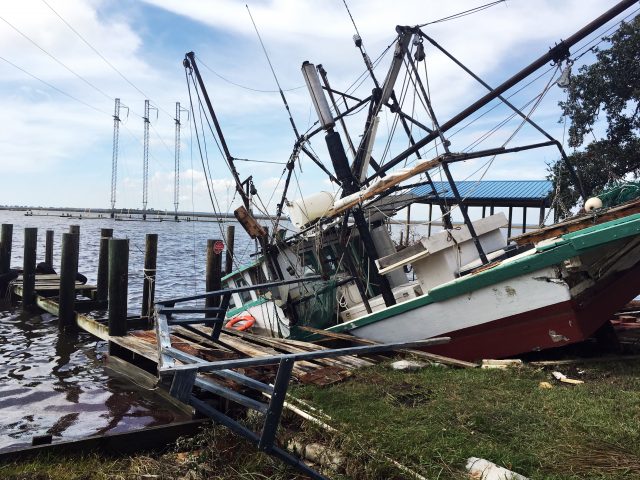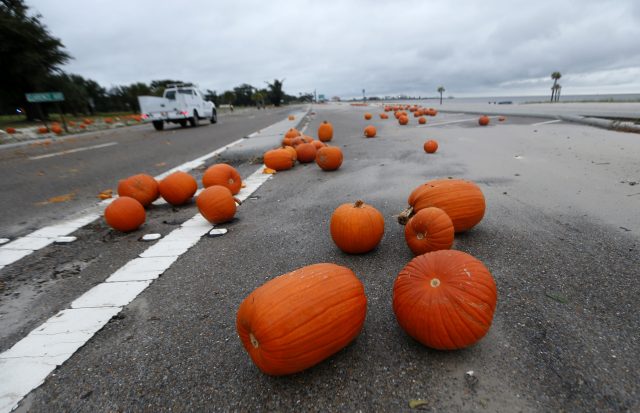
Hurricane Nate brought a burst of flooding and power cuts to the US Gulf Coast – but spared the region the kind of catastrophic damage left by a series of hurricanes in recent weeks.
Nate – the first hurricane to make landfall in Mississippi since Katrina in 2005 – quickly lost strength, with its winds diminishing to a tropical depression as it pushed northward into Alabama and towards Georgia with heavy rain.
 (PA graphic)
(PA graphic)
It was a Category 1 hurricane when it came ashore outside Biloxi in Mississippi early on Sunday, its second landfall after initially hitting south-eastern Louisiana on Saturday evening.
No storm-related deaths or injuries were immediately reported.
FEMA and first responders are working hard (yet again) on Hurricane Nate. Military helping. Very much under control!
— Donald J. Trump (@realDonaldTrump) October 8, 2017
Mississippi governor Phil Bryant praised state and local officials and coastal residents for working together to avoid loss of life.
Lee Smithson, director of the state emergency management agency, said damage from Nate was minimised in part because of work done and lessons learned from Katrina.
“If that same storm would have hit us 15 years ago, the damage would have been extensive and we would have had loss of life,” Mr Smithson said of Nate.
The MS Coast took a hard hit from Nate. The lack of major damage is a testament to the strong and smart rebuilding since Katrina. @fema
— MSEMA (@MSEMA) October 8, 2017
“But we have rebuilt the coast in the aftermath of Katrina higher and stronger.”
Nate knocked out power to more than 100,000 residents in Mississippi, Alabama, Louisiana and Florida, but crews worked on repairs and it appeared many of the outages had been restored within 24 hours.
As of Sunday evening, Alabama Power said it had electricity back to more than 64,000 customers and some 36,000 remained without power, while in Mississippi power had been restored to more than 21,000 customers.
 A shrimp boat is sunk at its mooring along the Pascagoula River in Moss Point, Mississippi (Jeff Amy/AP)
A shrimp boat is sunk at its mooring along the Pascagoula River in Moss Point, Mississippi (Jeff Amy/AP)
In Louisiana, there were scattered outages during the storm, while Florida governor Rick Scott said 6,800 customers had lost power in his state.
Before Nate sped past Mexico’s Yucatan Peninsula late on Friday and entered the Gulf of Mexico, it drenched Central America with rains that left at least 22 people dead.
But Nate did not approach the intensity of Harvey, Irma and Maria – powerful storms that left behind massive destruction during 2017’s exceptionally busy hurricane season.
“We are thankful because this looked like it was going to be a freight train barrelling through the city,” said Vincent Creel, a spokesman for the city of Biloxi.
Crews had to remove more than 1,000 pumpkins blown on to Highway 90 in Pass Christian, west of Gulfport in Mississippi in the winds.
 Pumpkins are strewn along Highway 90 in Pass Christian (Gerald Herbert/AP)
Pumpkins are strewn along Highway 90 in Pass Christian (Gerald Herbert/AP)
Willie Cook, 75, spent his morning chopping down a pecan tree that fell in his back garden.
He said Nate was nothing like Katrina, which pushed 8ft (2.4 metres) of water into his east Biloxi house.
“The wind was blowing, but it wasn’t too rough,” Mr Cook said of Nate.


Why are you making commenting on The Herald only available to subscribers?
It should have been a safe space for informed debate, somewhere for readers to discuss issues around the biggest stories of the day, but all too often the below the line comments on most websites have become bogged down by off-topic discussions and abuse.
heraldscotland.com is tackling this problem by allowing only subscribers to comment.
We are doing this to improve the experience for our loyal readers and we believe it will reduce the ability of trolls and troublemakers, who occasionally find their way onto our site, to abuse our journalists and readers. We also hope it will help the comments section fulfil its promise as a part of Scotland's conversation with itself.
We are lucky at The Herald. We are read by an informed, educated readership who can add their knowledge and insights to our stories.
That is invaluable.
We are making the subscriber-only change to support our valued readers, who tell us they don't want the site cluttered up with irrelevant comments, untruths and abuse.
In the past, the journalist’s job was to collect and distribute information to the audience. Technology means that readers can shape a discussion. We look forward to hearing from you on heraldscotland.com
Comments & Moderation
Readers’ comments: You are personally liable for the content of any comments you upload to this website, so please act responsibly. We do not pre-moderate or monitor readers’ comments appearing on our websites, but we do post-moderate in response to complaints we receive or otherwise when a potential problem comes to our attention. You can make a complaint by using the ‘report this post’ link . We may then apply our discretion under the user terms to amend or delete comments.
Post moderation is undertaken full-time 9am-6pm on weekdays, and on a part-time basis outwith those hours.
Read the rules here